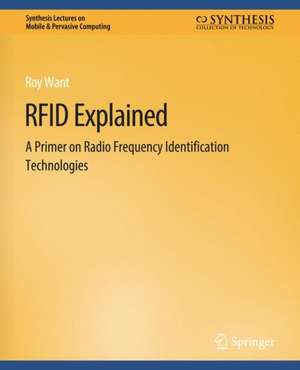RFID Explained: A Primer on Radio Frequency Identification Technologies: Synthesis Lectures on Mobile & Pervasive Computing
Autor Roy Wanten Limba Engleză Paperback – 31 dec 2007
Preț: 191.31 lei
Nou
Puncte Express: 287
Preț estimativ în valută:
36.61€ • 39.89$ • 30.85£
36.61€ • 39.89$ • 30.85£
Carte tipărită la comandă
Livrare economică 19-25 aprilie
Preluare comenzi: 021 569.72.76
Specificații
ISBN-13: 9783031013461
ISBN-10: 3031013468
Ilustrații: X, 86 p.
Dimensiuni: 191 x 235 mm
Editura: Springer International Publishing
Colecția Springer
Seria Synthesis Lectures on Mobile & Pervasive Computing
Locul publicării:Cham, Switzerland
ISBN-10: 3031013468
Ilustrații: X, 86 p.
Dimensiuni: 191 x 235 mm
Editura: Springer International Publishing
Colecția Springer
Seria Synthesis Lectures on Mobile & Pervasive Computing
Locul publicării:Cham, Switzerland
Cuprins
Introduction.- Principles of Radio Frequency Identification.- RFID Industry Standards.- Reading Collected RFID Tags.- Applications of RFID Tagging.- RFID Incorporating Sensing.- Deployment and Experience with RFID Systems.- Privacy, Kill Switches, and Blocker Tags.- Opportunities for RFID Integrated with Memory.- Challenges, Future Technology, and Conclusion.
Notă biografică
Roy Want is a Principal Engineer at Intel Research. Interests include embedded systems, mobile computing and automatic identification. Want received a BA in computer science from Cambridge University, UK in 1983 and earned a Ph.D. in distributed multimedia-systems in 1988. He joined Xerox PARC's Ubiquitous Computing program in 1991 and managed the Embedded Systems area, later earning the title of Principal Scientist. He joined Intel Research in 2000. Want is the author of more than 50 publications in the area of mobile and distributed systems; and holds 52 patents. He is a Fellow of both the IEEE and ACM.














